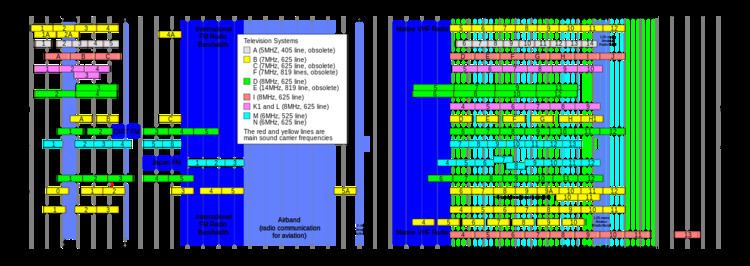 | ||
The following tables show the frequencies assigned to broadcast television channels in various regions of the world, along with the ITU letter designator for the system used. The frequencies shown are for the analogue video and audio carriers. The channel itself occupies several megahertz of bandwidth. For example, North American channel 2 occupies the spectrum from 54 to 60 MHz. See Broadcast television systems for a table of signal characteristics, including bandwidth, by ITU letter designator.
Contents
- North and South America most countries South Korea Taiwan and the Philippines
- Assignments since February 25 1946
- Japan
- Republic of Ireland
- Western Europe Greenland and most countries in Asia Africa and Oceania
- France
- Italy
- East Germany DDR
- Australia
- New Zealand
- Americas most countries South Korea Taiwan and the Philippines
- United Kingdom Ireland Hong Kong Macau Falkland Islands and Southern Africa
- Western Europe Greenland most countries in Asia and Africa and most of Oceania
- References
North and South America (most countries), South Korea, Taiwan and the Philippines
Channel 1 was finally withdrawn on June 14, 1948, and allocated to fixed and mobile services. In some countries using the standard, channels 5 and 6 are allocated to non-broadcast services. An international agreement provides for a unified television bandplan, with 6-MHz channels throughout ITU Region II for both VHF and UHF bands, except for French territories, Falkland Islands, Greenland and Netherlands Antilles. Not all territories observe this bandplan.
During World War II the frequencies originally assigned as channels 13 to 18 were appropriated by the military, which still uses them. It was also decided to move the allocation for FM radio from the 42-50 MHz band to a larger 88-106 MHz band (later extended to the current 88-108 MHz FM band). This required a reassignment of the VHF channels to the plan currently in use. [1]
Assignments since February 25, 1946
Notes:
Note: FM channel 200, 87.9 MHz, overlaps TV 6. This is used only by KSFH and K200AA. Channel 6A is only used in South Korea and the Philippines.
TV 6 analog audio can be heard on FM 87.75 on most broadcast radio receivers as well as theoretically on any European TV tuned to channel 4A, but at lower volume than wideband FM broadcast stations.
Japan
Note : Basically the frequency spacing for each channel is 6 MHz as the countries above, except between channels 7 and 8 (which overlap).
Republic of Ireland
Note: Channel A was never used terrestrially. The only System I Band I transmitter on Channel B was RTÉ One from the Maghera, Co. Clare transmitter during 1963-1999. Channel A was initially intended for use at Maghera but Channel B was used instead because of the risk of interference to (overspill) reception of BBC 405 line transmissions [2]. It was moved to Channel E due to interference from distant transmitters during certain atmospheric conditions and other reasons. Channel C was used by a relay transmitter in Glanmire, Co. Cork. There are currently no Band I Channels used in Ireland (except on cable TV, and these have mostly been phased out for DOCSIS use) and no plans to resume using them. Most Irish Cable TV systems do not follow the above channel plan as their analogue (video) carriers are usually at multiples of 8 MHz (i.e. 176, 184, 192 MHz etc. in Band III)
Western Europe, Greenland and most countries in Asia, Africa and Oceania
France
Italy
Channels A through H are indicated in many European TVs as Channels 13-20. Channels B through H2 are identical to Channel E4 and up. Channel A video carrier is the same as Channel E2 video carrier and thus it used to be common that the audio from a distant TV station on channel E2 received via Sporadic E interferes with Channel A video and vice versa.
East Germany (DDR)
In its very early days DFF made some test transmissions using the D/K standard (6.5 MHz audio) before reverting (around 1957) to System B/G (5.5 MHz audio) but still (initially) using some oddball frequencies # .
# From 1960 onwards (West) European standard channels were adopted.
Australia
Note
New Zealand
Americas (most countries), South Korea, Taiwan and the Philippines
See North American broadcast television frequencies for frequencies used in North America.
Japan
Note: Channels 13-62 are used for analog and digital TV broadcasting.
Frequency spacing for each channel in Japan is the same as in the countries listed above, but the channel numbers are 1 lower than in those countries; for example, channel 13 in Japan is on the same frequency as channel 14 in North and South America (most countries), South Korea, Taiwan, and the Philippines.
United Kingdom, Ireland, Hong Kong, Macau, Falkland Islands and Southern Africa
NOTE: Channels 21 to 60 used for DVB-T Digital TV broadcasting in the UK, with the exception of Channel 38, which is used by PMSE. Channels 61 to 69 used for 4G LTE.
NOTE: Channel 69 was not used for TV broadcasting in the UK, used by MOD and until 2012 by PMSE.
NOTE: PAL I was withdrawn from broadcasting use in the UK during 2012 and 2013.
Western Europe, Greenland, most countries in Asia and Africa, and most of Oceania
Australia
Channels above C52 are being progressively phased out since the introduction of digital television and rationalisation of the spectrum
